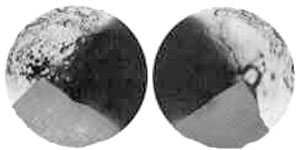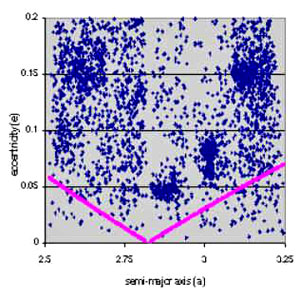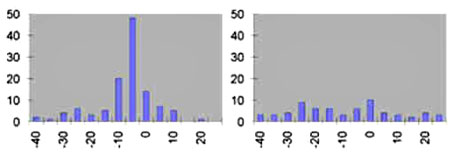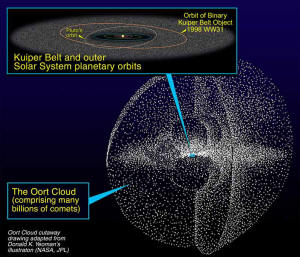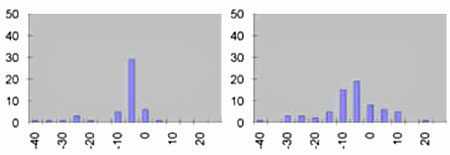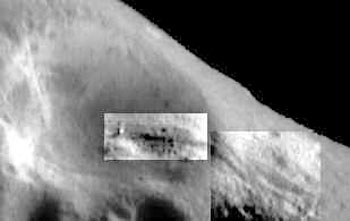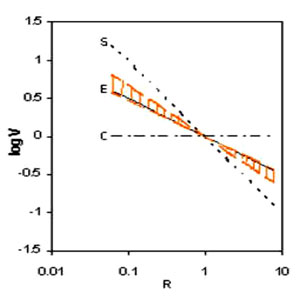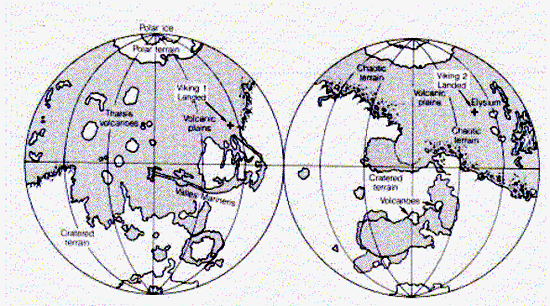|
|
|
by Tom Van Flandern
from
MetaResearch Website
Abstract
The hypothesis of the explosion of a number of planets and moons of our solar system during its 4.6-billion-year history is in excellent accord with all known observational constraints, even without adjustable parameters.
Many of its boldest predictions have been fulfilled. In most instances, these predictions were judged highly unlikely by the several standard models the eph would replace. And in several cases, the entire model was at risk to be falsified if the prediction failed.
The successful predictions include:
Where It Began – the
Titius-Bode Law of Planetary Spacing
The table shows the Titius-Bode law of planetary spacing, comparing actual and formula values. This in turn drew attention to the large gap between Mars and Jupiter, apparently just large enough for one additional planet.
Today we know of tens of thousands of “minor planets” or asteroids with planet-like orbits at that average mean distance from the Sun.
With the discovery of the second asteroid in 1802, Olbers proposed that many more asteroids would be found because the planet that belonged at that distance must have exploded.
This marked the birth of the exploded planet hypothesis. It seemed the most reasonable explanation until 1814, when Lagrange found that the highly elongated orbits of comets could also be readily explained by such a planetary explosion.
That, unfortunately, challenged the prevailing theory of cometary origins of the times, the Laplacian primeval solar nebula hypothesis. Comets were supposed to be primitive bodies left over from the solar nebula in the outer solar system. This challenge incited Laplace supporters to attack the exploded planet hypothesis (eph).
Lagrange died in the same year, and
support for his viewpoint died with him when no one else was willing
to step into the line of fire.
If they came from an exploded
planet, all of them should reach some common distance from the Sun,
the distance at which the explosion occurred, somewhere along each
orbit. But if asteroids came from the primeval solar nebula, then
roughly circular, non-intersecting orbits ought to occur over a wide
range of solar distances between Mars and Jupiter.
Because Newcomb didn’t realize how many asteroids would eventually be found, he didn’t appreciate the frequency of asteroid collisions, which tend (on average) to circularize orbits.
He also did not appreciate that
planetary perturbations, especially by Jupiter, can change the
long-term average eccentricity (degree of circularity) of each
asteroid’s orbit. Finally, Newcomb did not consider that more than
one planet might have exploded, contributing additional asteroids
with some different mean distance. In Newcomb’s time, no evidence
existed to justify these complications.
This article will review that
evidence.
That makes the total mass of the asteroid
belt only about 0.001 of the mass of the Earth. A frequently asked
question is, if a major planet exploded, where is the rest of its
mass?
Bodies smaller than Earth, such as our Moon, would
leave a substantially higher percentage of their mass in asteroids.
But the Moon has only about 0.01 of Earth’s mass to begin with.
Various chondrite meteorites (by far the most
common type) show all stages of partial melting from mild to almost
completely vaporized. Indeed, it is the abundant melt droplets,
called “chondrules”, that give chondrite meteorites their name.
In other
words, the asteroid belt is certainly the remnant of a larger
population of bodies, many of which gravitationally escaped the
solar system or collided with the Sun or planets.
Comets are so strikingly similar to asteroids that no defining characteristic to distinguish one from the other has yet been devised. This is rather opposite to expectations of the solar nebula hypothesis, because comets should have been formed in the outer solar system far from the main asteroid belt.
A traceback of orbits of “new” comets (that have not mixed with the planets before) indicates statistically that these probably originated at a common time and place, 3.2 Mya. [i]
But it should be noted that galactic tidal forces would eliminate comets from any bodies that exploded prior to 10 Mya, so only very recent explosions can produce comets that would remain visible today.
Figure 1. Saturn’s
black-and-white moon Iapetus.
A major explosion would send a blast wave through the solar system, blackening exposed, airless surfaces in its path.
Most such solar system surfaces are indeed blackened, even for icy satellites. But a few cases have such slow rotation that only a little over half of the moon gets blackened.
Saturn’s
moon Iapetus is one such case, because its rotation period is nearly
80 days long. Figure 1 shows a spacecraft image of
Iapetus. One side
is icy bright; the other is coal black. The difference in albedo is
a factor of five. Gray areas are extrapolations of black areas into
regions not yet photographed. As such, they represent a prediction
of what will be seen when a future spacecraft (Cassini?) completes
this photography.
Moreover, collisions tend to cause existing satellites to escape, leading to asteroid “families” (many of which are seen). Our prediction that asteroids and comets would often be found to have satellites has been confirmed in recent years.
The first spacecraft finding (by Galileo) was of moon Dactyl
orbiting asteroid Ida in 1993. More recently, Hubble imagery found
that
Comet Hale-Bopp has at least one,
and possibly three or more, secondary nuclei.
[ii]
The discovery of one, and probably two,
new asteroid belts orbiting the Sun beyond Neptune is especially
suggestive, given that the main asteroid belt is apparently of
exploded planet origin. Evidence of the “late heavy bombardment” in
the early solar system is another strong indicator. These points are
discussed later in this article.
Cosmic ray exposure ages of meteorites indicate how long these bodies have been exposed to space, because cosmic rays can penetrate only about a meter into a solid body. Collisional break-up can reset the exposure ages for some meteorites, and produce “double exposure” or other complexities for others.
The data show clusterings of exposure ages around several
different primary epochs, suggesting multiple explosion epochs.
That parent body mass is
almost certainly less than the size of our Moon, because the
carbonaceous meteorites most closely associated with comets indicate
a parent body that was too small to chemically differentiate.
We included the numbered asteroids having periods between one-half and one-third the period of Jupiter. If the primeval solar nebula hypothesis were correct, numbers of asteroids with near-zero eccentricity would be roughly equal at all mean distances well away from the orbits of Mars and Jupiter.
Indeed, nebular drag and collisions would ensure that orbits with zero eccentricity were preferred. By contrast, if the exploded planet hypothesis is correct, a minimum eccentricity, increasing to either side of a mean distance of about 2.8 au, should be evident in the plot.
The “V”-shaped line shows the theoretical minimum eccentricity, according to the eph.
Figure 2. Semi-major axis (mean distance from Sun) vs. eccentricity
for main belt
asteroids near theoretical parent planet distance, showing an
explosion signature. We see in Figure 2 that, despite about as much scattering across the minimum line as expected (increasing toward Jupiter on the right), the densest number counts trend up and away, paralleling the V-shaped line, on both sides of the inferred exploded planet distance, 2.82 au.
It is difficult to imagine this explosion-predicted low-eccentricity avoidance occurring by chance – especially since the primeval solar nebula hypothesis predicts a preference for low eccentricity values.
What we are seeing here is Newcomb’s
argument applied with modern knowledge and data. The expected
characteristic of fragments that originated in an explosion is seen.
The expected characteristic of objects present since the solar
system’s beginning, even if only collisional fragments thereof, is
not seen.
Figure 3. Comet energies before (left) and after (right) passage through planetary region.
Plot shows number of
comets (ordinate) versus energy parameter (abscissa).
Astonishingly, a great many comets are discovered that have energy parameter values close to zero, the threshold of gravitational escape, in units where Earth’s energy parameter is –100,000. Before mixing with the planets, a clustering of energy parameters near –5 exists, as shown in the left half of Figure 3.
However, as these same comets recede
again far from the planets, the clustering property is virtually
destroyed, as shown on the right side of Figure 3. The scattering is
so great that no clustering near –5 or any other value will exist
the next time around. So these comets must have been making their
first visit to the planetary part of the solar system. For that
reason, they are called “new comets”.
Because of these traits and a mean distance of 1000 times greater than that of Pluto from the Sun, the far-away source of Oort’s new comets was designated the “Oort cloud”.
The exploded planet hypothesis predicted something similar.
The energy parameter implies a particular period of revolution around the Sun. If a planet exploded “x” years ago, then new comets returning for the first time today would arrive on orbits with period “x”. Comets with shorter periods would have returned in the past, mixing with the planets and eventually being eliminated (or now in the process of being eliminated).
Comets with longer periods would not yet have returned for the first time. So the eph predicts that all new comets should have the same period “x”, and therefore the same energy parameter corresponding to a period of “x”.
The center of the spike on the left side of Figure 3 corresponds to a period of 3.2 million years, which is therefore the time since the last explosion event.
Figure 4. Comet energies before passage through planetary region for class 1A comets (best orbits) on left,
and for classes 1B,
2A, 2B comets (less accurate orbits) on right.
In the 1970s, astronomer Opik devised a test to determine if the Oort cloud really existed, or if the “clustering” was really a spike, as predicted by the exploded planet hypothesis.
The published orbits of new comets have an orbit quality parameter, which indicates which orbits ought to be very accurate because of a long observed arc with lots of well-distributed observations (class 1A); and which orbits ought to have higher observational errors because of short arcs and/or fewer or poorly distributed observations (classes 1B, 2A and 2B).
In the standard model with an Oort cloud
of comets, there is no obvious way to tell the difference between
comets anywhere in the energy parameter range on the left side of
Figure 3. So there is no reason for any observational class of comet
to be other than randomly distributed among all the comets in that
figure. If all the orbits could be improved to class 1A, the overall
average appearance of the distribution ought to be unchanged.
So comets of observational classes 1B, 2A and 2B ought to have a broader distribution than class 1A comets because 1A comet orbits are closer to reality (less observational error).
And if all the comets of
classes 1B, 2A and 2B were improved to class 1A, the whole
distribution should narrow greatly. Opik’s test was to separate
comets of class 1A from the other classes to determine if the
distribution was significantly broader for the other classes than
for class 1A (indicating the eph is right), or essentially the same
for both groups (indicating the Oort cloud is right).
(Note that these orbit quality codes are assigned by cometary astronomers using published criteria. This author had no role in determining these designations.)
The left side
shows 2.6 times as many comets in the central spike as in the
immediately adjoining bins combined. The right side shows only 0.8
times as many comets in the central spike as in the two adjoining
bins, and has a clearly broader distribution.
Anyone working with the published new comet data could arrive at the same conclusion. If skeptical readers suspect that the author may have consciously or unconsciously selected the data so as to give a favorable outcome, recall that Opik, who strongly doubted the eph when he thought of this test, came to the same conclusion even with the smaller amount of comet data available to him 20 years ago.
In essence, we have proved that Lagrange’s instinct 200 years ago was right on target:
Satellites of
Asteroids and Comets
For example, in a break-up event, most debris
escapes, and what does not falls back onto the surface it was
ejected from after one orbit. Even if it managed to barely miss the
surface, tidal forces would bring it back down in short order.
Specifically, spacecraft visiting
asteroids (or comets) should find at least one of the larger debris
bodies (satellites) in orbit around the asteroid (or comet) primary
nucleus. This prediction, also published in
[iii] and
[iv], was
considered extremely unlikely by mainstream astronomers, one of whom
made a public wager with me that it would not happen.
A year before the NEAR spacecraft went into orbit around asteroid Eros in February 2000, I altered the general prediction of satellites to a more specific one: If the gravity field of an asteroid is too irregular for stable orbits to exist near the synchronous orbit (as is the case for Eros), then the debris that once orbited the nucleus would now be found as intact boulders lying on the asteroid surface. [vi]
These would be easy to identify because of their tangential touchdown onto the asteroid, resulting in considerable rolling from their orbital momentum.
So “roll marks” were the predicted identifier to show that boulders were former satellites.
Figure 5. NEAR spacecraft photo of a large crater on asteroid Eros
with a trail across a
crater rim, leading to an interior boulder.
The first image taken by the spacecraft from orbit around Eros is shown in Figure 5.
The two blocks are
areas where contrast was stretched for better visibility of the
“roll mark”. The image appears to show a track starting in a random
location, going up the outside wall of a crater, down the inside
wall, and ending in a 50-meter boulder. Many additional examples of
boulders, tracks, and boulders at the ends of tracks can be seen in
later spacecraft images.
Although this finding was controversial, the satellite interpretation was subsequently confirmed as the most reasonable explanation by other investigators. [viii]
The largest of these secondary bodies is a
30-km satellite of an estimated 70-km primary nucleus.
The eph leads to what I call the “satellite model” as an explanation of what a comet is and how it behaves. The standard model for comets is the so-called “dirty snowball” model. In the former case, comets are rocky asteroids surrounded by a debris cloud. In the latter case, they are a snow-ice mixture contaminated with dust packed into a lone nucleus that is eruptive when exposed to sunlight.
It ought to be easy to
distinguish these two extreme possibilities from observations. And
indeed, it is. One of the strongest such tests follows.
“Splitting” is required by the
satellite model because, as the comet approaches the Sun and its
gravitational sphere of influence shrinks, some outer satellites may
find themselves outside the sphere of influence. Such objects then
escape into independent solar orbits. The escape event will appear
to a distant observer as a “split” of the comet into two or more
pieces.
Alternatively, the energy for the split in the dirty snowball model might come from solar light, solar heat, solar wind, solar magnetism, or something associated with the Sun. In all such cases, the energy ought to increase inversely with the square of solar distance, which will yield relative velocities that are inverse with solar distance to the first power.
The dirty snowball model, because it does not predict such splits, is not specific about which mechanism, a solar or a non-solar energy source, is the correct one.
Figure 6. Comet split velocities (V) vs. solar distance (R). C = comet internal energy; S = solar energy; E = eph satellite model;
shaded area is one
sigma observational upper and lower bounds.
By contrast, the eph and its satellite model require gravitational escapes of satellite comets as the sphere of influence of the primary nucleus shrinks upon approach to the Sun.
The laws of dynamics require that “split” fragment
velocities be escape velocities, which vary inversely with the
square root of solar distance. Any other observed relationship would
falsify the model.
These
represent a comet-internal energy source, a solar energy source, and
gravitational escape energies as predicted by the eph, respectively.
All curves have been shifted vertically to intersect at 1 au
(about 150 million kilometers) because
only the slopes are relevant.
There is direct evidence for the explosion of one or more very large planets in the very early solar system. From studies of lunar rocks it is now known that the Moon, and presumably the entire solar system with it, underwent a “late heavy bombardment” of unknown origin not long after the major planets formed.
The following are relevant descriptions of the event: [ix]
In short, the late heavy bombardment, a
real solar system event, sounds like an early planetary explosion
event.
This last point might need some clarification.
If an event occurs at a great distance from the Earth, it would potentially affect just one hemisphere of the Earth if it is a quite sudden phenomenon. But if it lasts for more than 12 hours, as would occur for the spread in arrival times of a blast wave from a distant planet explosion, then the Earth would rotate on its axis, exposing most parts of the planet to the event.
However, because of the tilt of the Earth’s axis to the mean plane of the planets, one polar region of Earth would remain continuously hidden from such an event unless its duration continued over many months. For the K/T boundary event, apparently one of Earth’s polar regions has shielded.
This
emphasizes the likelihood that the event was of distant origin and
global extent, rather than terrestrial origin and concentrated
mainly in one area (as for a single major impact such as the Chicxulub crater formation in the Yucatan).
The above summarizes evidence that Mars was not an original planet, but rather a moon of a now-exploded planet occupying that approximate orbit.
Many of these points are the expected consequences of having a massive planet blow up nearby, thereby blasting the facing hemisphere and leaving the shielded hemisphere relatively unscathed.
Especially significant in this regard is the fact that half of Mars is saturated with craters, and half is only sparsely cratered.
Moreover, the crustal thickness has apparently been augmented over one hemisphere by up to 20 km or so, gradually tapering off near the hemisphere boundaries. This “crustal dichotomy” is also readily seen in Martian elevation maps, such as in Figure 7.
Figure 7. Mars crustal dichotomy. Cratered highlands (white), lowland plains (shaded). Left: western hemisphere, 180° à 0°. Right: eastern hemisphere, 360° à 180°.
From Christiansen &
Hamblin (1995). [x]
The Original Solar
System
These were probably gas giant planets with moons of significant size, such as Mars, before they exploded.
We have hints of two more asteroid belts, probably
from the explosions of two more planets (“Planet T" and “Planet X")
beyond Neptune. And we have hints for two extra-large gas giant
planets, “Planet A” and “Planet B”, that exploded back near the
solar system beginning.
This model makes a major prediction that will soon be tested: Extrasolar planets should arise in twin pairs also, with 2-to-1 orbital period resonances common.
If so, then many
cases that now appear to be single massive planets on highly
elliptical orbits will turn out, when enough observations are
accumulated, to be twin resonant planets on near-circular orbits.
We will mention three theoretical conjectures, although in-depth work must await a wider recognition of the phenomenon in the field at large.
Conclusion
Two additional successes and one
additional new prediction will be mentioned briefly here.
This refers to an obvious corollary of the eph, never explicitly put in writing in so many words.
If meteorites come from the explosion of planet-sized bodies, the water from such bodies can be ocean water (as on Earth and as suspected for Jupiter’s moon Europa), and would therefore be expected to contain salt from run-off of minerals from solid portions of the planet.
Only recently has meteorite water been tested for salt content for the first time, with the surprising result that sodium chloride was found. [xvii] Certain aspects of this discovery suggest that water was flowing on the parent body from which the meteorite came.
True, unless one had
the exploded planet hypothesis in mind.
Abstract (5): the time and peak rate of the 1999 Leonid meteor storm
Esko Lyytinen of Finland used the exploded planet hypothesis as a model for understanding and predicting the behavior of meteor storms.
These had never before been successfully predicted. Although nearly a dozen professional astronomers attempted predictions for the possible November 1999 storm, only three teams had results that were correct for the time of the event, and only Lyytinen had both the time and the peak meteor rate correct to within the stated error bars.
The complete story of this prediction,
the expedition, and its successful conclusion are beyond the scope
of this paper, but may be found in the reference.
[xix]
But sadly, research funding is still
being poured almost exclusively into competitor theories.
|


